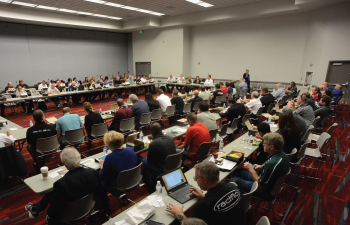SEMA News—April 2013
INTERNATIONAL
By Alysha Webb
Case Study: Globalizing Sales
One Company’s Methods May Be a Model for Others
|
|
|
“We see the potential for double-digit growth in our international sales over the next 24 to 36 months, both on the consumer side and the industrial side,” said David Canitz, manager of the company’s international markets.
Royal Purple’s consumer products are high-performance lubricants for automotive, motorcycle, marine and racing enthusiasts. Its industrial product is high-performance synthetic oil to the petroleum industry. Its business in the United States is about 55% industrial and 43% consumer. Internationally, however, consumer products account for only about 20% of sales.
The company, based in Porter, Texas, now aims to change that. It has embarked on an ambitious program to grow sales of its consumer products by up to one-third this year.
The smaller market for consumer products was mainly because of the high cost of finding distributors and marketing the consumer products, Canitz said. But in July of 2012, privately owned Royal Purple was purchased by Calumet Specialty Products, a much larger, publicly traded company. That sale will provide the needed resources to grow international sales by adding more distributors.
|
SEMA organizes a trip each spring to the Middle East and each September to China to assist members in better understanding these key emerging markets and to meet face to face with potential buyers. For more information on these and other SEMA international resources, such as hands-on access to vehicles popular around the world but not sold in the United States, make and model data for key countries, and top strategies for meeting with international buyers at the SEMA Show, contact SEMA Director of International Relations Linda Spencer. |
||
“You know there is a good relationship when you have traveled to their country and they want to invite you to their homes for dinner or a drink,” he said.
Given the growing number of international attendees at the SEMA Show, it is also “a great place to make initial contact without the expense of flying all over the world,” said Canitz. SEMA’s business-development conferences are also opportunities to meet potential distributors, he said.
Canitz attended the Abu Dhabi conference last April, where he met owners of performance and repair shops and entrepreneurs who wanted to sell Royal Purple’s high-performance consumer lubricants.
“Without SEMA, it would have taken a long time to go out and locate those people,” he said, since most of Royal Purple’s previous business in the Middle East was for industrial products. “The last container for my Middle East distributor, a third was retail product, whereas it would have been 5% before.”
Overseas Distribution Basics
|
|
|
If you are unsure about an overseas distributor, call another SEMA-member company and ask about them, he suggested. Royal Purple was considering a distributor in the Middle East that also sold another SEMA member’s products. Canitz called that company and got very favorable responses.
Next, give distributors time to grow into the job. Royal Purple let one new Middle East distributor “mature” for about 20 months. “This year, they are poised to get some good sales,” said Canitz.
He also advised against giving new distributors “exclusive rights.” The legal interpretations of the term can differ vastly from country to country. Royal Purple does not set up competing distributors, but it also doesn’t grant exclusive rights.
Canitz also advised that companies should establish whether there is a market for their products in a new country before pursuing sales there. Each country means an investment of not just money but also time.
Countries with oil industries are good candidates for Royal Purple’s industrial products. Finding the right overseas markets for its consumer products is trickier. Canitz looks for countries where consumers have sufficient disposable income and a retail distribution system similar to the one in the United States. He likes Mexico for that reason.
Similar vehicles are also helpful. Royal Purple is successful in Australia because it has chain stores and General Motors and Ford are there in force, said Canitz. “I would recommend Australia for any high-performance SEMA manufacturer,” he said.
The U.S. Department of Commerce is another good resource, he said. “There are cultural differences that SEMA and the U.S. Department of Commerce can help you understand,” he explained.
China is next on Canitz’s list of overseas markets for consumer products. He plans to attend the SEMA business conference there.
“We understand how the industrial distribution system works in China but not how the retail works,” he said. “I hope we can explore that through the SEMA China program.”










